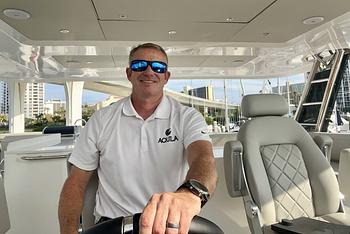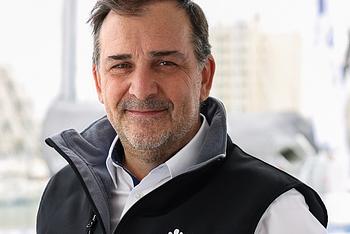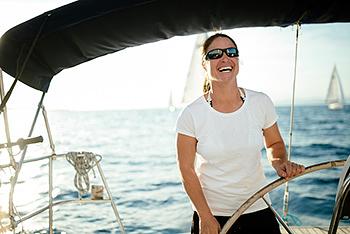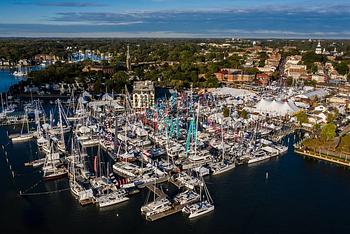"Nine Would Leave, Eight Would Return, One Would Never Be Seen Again..."
To celebrate the forthcoming release of The Mercy, the story of the 1969 Golden Globe Race and English amateur sailor, Donald Crowhurst, starring Colin Firth and Rachel Weisz, we take a look at the true story behind the film’s drama.
In the late 60s, yachting fever gripped Great Britain and indeed much of the world. In May 1967, Sir Francis Chichester had returned to Plymouth after completing the world’s first solo circumnavigation of the globe, thus heralding in a golden new Elizabethan age of seafaring exploits. Thousands of onlookers lined the streets to give Chichester a hero’s welcome in scenes reminiscent of the tickertape parades that would a couple years later greet the returning Apollo astronauts from the moon landing. The world was slowly recovering from the ravages of a cataclysmic world war. In this era of the Beatles and free love, of civil rights protests and newly won freedoms, a new spirit of adventure was born and was taking hold of a populous desperate for new challenges. The freedom of the seas was a crucial element to this revolution of adventure and one great global yacht race could be interpreted as representing this new era in a microcosm.
The 1969, Sunday Times Golden Globe Race would produce a cast of characters, heroes and villains, and a script that would be considered far-fetched if written for a feature film. One man would become a national hero; one would become a sailing legend; and one would become a figure of mystery and tragedy of Shakespearean dimensions. The Sunday Times Golden Globe Race was the precursor to Vendee Globe round-the -world races and the BOC Challenge and would be the race of a lifetime. Nine sailors would start the race, eight men would survive the race yet only one would cross the finish line 312 days later.

The Birth of the Race
The very first single-handed circumnavigation of the world was made by Joshua Slocum between 1895 and 1898. However, Slocum’s voyage involved numerous stopovers. It was not until 1967 and Sir Francis Chichester in his yacht Gypsy Moth IV, that the first true solo circumnavigation at speed would be completed. Chichester’s nine months and one day voyage included 226 days of sailing time with one stop in Sydney, Australia.
Even before Chichester’s return to Plymouth, many sailors were turning their attention to the last great sailing challenge; a non-stop solo circumnavigation of the world. British sailor and ex-merchant marine officer, Robin Knox-Johnston was determined to become the first to successfully complete the circumnavigation and to this end, approached various UK newspapers for sponsorship. After being turned down by the Sunday Times who felt that Knox-Johnston’s chances of success were tiny and turned him down, he finally managed to secure sponsorship for the attempt from the Sunday Mirror. Knox-Johnston wasn’t alone in his plans and other sailors such as Bill King, John Ridgeway and Chay Blyth were preparing to mount their own attempts on the circumnavigation challenge. One of the most experienced sailors to consider attempting the challenge was the enigmatic Frenchman Bernard Moitessier. Moitessier had built an international reputation as both a sailor and as an author, writing of his exploits when sailing from France to Tahiti and back again via Cape Horn together with his wife. He felt however, that somehow profiting financially from the book sales of his exploits devalued the spiritual quality that he found so deeply within sailing and he sought a new challenge. He set his sights on the non-stop solo voyage around the world.
The Sunday Times had sponsored Chichester’s voyage and had subsequently been approached by several sailors for additional sponsorship for the non-stop circumnavigation. The newspaper however, were undecided which horse to back and did not want to tarnish their reputation by sponsoring a failed attempt. The newspaper hit upon the idea of sponsoring an entire race which would cover all the attempts about to be mounted. They stipulated that any non-entrant attempting the circumnavigation would automatically be entered into the race. The prize was twofold. The Golden Globe trophy would be presented to the first sailor to complete the challenge whilst the fastest voyage would receive a £5,000 prize, equivalent to just under £60,000 today. The competitors were to start from England and rather than all the boats starting at the same time, the voyages should simply begin between 1st June and the 31st October 1968. Sir Francis Chichester was to chair the panel of judges.
Early entrants to the race included Knox-Johnston, Moitessier, Bill Howell (who dropped out) and John Ridgeway but it was the entry of one man that really ignited the public's’ imagination.
Donald Crowhurst was born in British India in 1932. His father worked on the Indian railways whilst his mother was a school teacher and they moved the family back to England when India gained its independence. The family’s £5,000 savings didn’t last long in post-war Britain and they were soon beset by financial problems. After his father died, Donald was forced to leave school early and started an apprenticeship at the Royal Aircraft Establishment at Farnborough. By 1953, Donald had been commissioned as a pilot in the Royal Air Force. He subsequently served in the army before being discharged owing to a “disciplinary incident”. Upon leaving the services, Donald started an electronics business in Bridgwater. Crowhurst was a keen weekend sailor and an amateur inventor. He designed and built a handheld device to take bearings on marine and aviation radio beacons called the Navicator. Although he achieved small success selling the Navicator and other navigational equipment, Crowhurst’s business began to fail. Crowhurst decided to gain publicity and sponsorship by entering the Golden Globe Race. His main sponsor was British entrepreneur Stanley Best. Crowhurst mortgaged both his home and his business against Best’s substantial financial investment. However, this risk to his family’s financial security would weigh heavily on Crowhurst’s mind. Crowhurst announced his entrance into the competition on the 21st March 1968. He then hired Rodney Hallworth of the Daily Mail as his public relations officer. The newspaper would have exclusive access to Crowhurst during his attempt and would regularly report his progress.
The full starting line-up was as follows: Robin Knox-Johnston, Nigel Tetley, Bernard Moitessier, Chay Blyth, John Ridgeway, Bill King, Alex Carozzo, Loick Fougeron and weekend sailor, Donald Crowhurst.

The Race Begins
The first to set sail was John Ridgeway on the 1st June followed a week later by Chay Blyth on the 8th. Knox-Johnston left on the 14th June and quickly began to gain on the earlier boats in his heavily laden yet superior craft, Suhaili. Ridgeway was soon affected by the inherent loneliness of the single-handed sailor and was beginning to discover that his boat was far from suitable for the long-distance voyage. After rendezvousing with a friend off Madeira, he received some mail. This was technically prohibited in the rules of the race and therefore Ridgeway was effectively disqualified from the event. He considered the disqualification as petty and continued his voyage until, after struggling in heavy weather, retired from the race on the 21st July. Crowhurst, beset with problems and delays, was still to set sail.
By the end of July, both Blyth and Knox-Johnston were well down the Atlantic. Blyth led, although he was experiencing problems with his boat which developed several mechanical faults and was suffering in the high seas. Knox-Johnston’s keel was leaking but he otherwise was making solid progress. Like Ridgeway, Blyth was technically disqualified on the 15th August when he received assistance from the cargo ship, Gillian Gaggins whose engineers fixed his generator and replenished his food supply. He continued sailing for a short while but finally had to admit defeat when his boat deteriorated badly. On the 22nd August both Moitessier and Fougeron set off, followed two days later by King. With his craft lightened for speed, Moitessier set a gruelling pace more than twice as fast as Knox-Johnston had managed on the same leg. Nigel Tetley set sail on the 16th September. Crowhurst hadn’t even launched his trimaran design yet.
Finally, on the 23rd September, Crowhurst launched his boat, Teignmouth Electron, and she began a short series of sea trials. The craft was found to perform fine downwind but struggled in upwind performance- a somewhat ominous sign for its intended voyage. His start was delayed by a further 13 days as he struggled to sail the relatively short distance from Norfolk to Teignmouth, his intended start point. Crowhurst carried an air of confidence in his media appearances however, underneath this flimsy veneer, he had serious doubts and worries for the voyage.
Meanwhile Moitessier was making great progress. By the 20th October he had reached Cape Town and by the 28th October had covered 188 nautical miles and was into the Southern Ocean. Things were not going so well for two other competitors. Fougeron and King found themselves caught up in a severe storm. Fougeron suffered a severe knockdown whilst King’s boat was rolled, and his foremast lost. Both men retired from the race. By the 31st October, the last date for departure, Moitessier was 1,000 nautical miles east of Cape Town; Knox-Johnston was 4,000 nautical miles ahead, and Tetley was nearing Trindade. On this day the last two competitors set sail although neither man was truly ready for the epic voyage. Alex Carozzo was a highly regarded Italian sailor who, although he technically set sail on the 31st, returned straight back to his mooring to continue working unaided on his boat which he considered “unready for sea”. Crowhurst was arguably even less prepared. His boat barely finished, his self-righting system unbuilt and the entire boat a carpet of chaos of unstowed supplies. Nevertheless, under the watchful eyes of the cheering crowd of thousands who had turned out to witness him leave, Crowhurst set sail on the start of his circumnavigation attempt. He was cutting it fine being so close to the deadline.
By mid-November, both Crowhurst’s deficiencies as a sailor, and the unprepared craft’s faults were already starting to show. Crucial repair materials had been left behind in Teignmouth, and by the 15th November, Crowhurst was under no illusions that his craft was fit for the conditions he would be facing. Nevertheless, he continued his voyage.
Alex Carozzo retired for medical reasons on the 14th November. This was followed by the further retirements of both King and Fougeron leaving just four boats in the race; Knox-Johnston, Moitessier, Tetley and the unlikely but plucky Crowhurst.
Crowhurst’s Voyage of Folly and Falsehoods
By early December, some remarkable news reached Rodney Hallworth’s desk at the Daily Mail. Crowhurst was reporting that he was now making excellent progress including a day’s run on the 8th December of 243 nautical miles, a new 24-hour record. Whilst some rejoiced others remained sceptical. Race panel chair, Sir Francis Chichester was himself unconvinced as of the validity of the accounts being reported.
Unbeknown to the newspaper reading masses, Crowhurst had been transmitting knowingly false positions and times. In the act of a desperate man, Crowhurst had been keeping two logs; one accurate and one faked. Faced with the choice of humiliation and financial suicide, and realising that he only had around a 50/50 chance of surviving the voyage, he began an elaborate deception. He planned to stay in the South Atlantic for several months whilst the other surviving boats continued their course in the Southern Ocean, to falsify his log book, and then slip back into the race once his competitors had passed him on the return leg to England. He was relying on only the winner’s logs would be scrutinised thoroughly and his false logs passing a cursory inspection. Crowhurst had been deliberately ambiguous in his radio reports throughout the voyage and by the 6th December, had been filing false reports back to Hallworth. He even stopped once in South America to make repairs to his boat, a violation of the rules of the race. Whilst Crowhurst cheated his way into the history books, one man was about to create a legend.

Moitessier the Legend
The enigmatic Frenchman, Moitessier had fast become the favourite to win the race. However, for Moitessier aboard the Joshua Slocum, all was not well. On the 20th October, and off the Cape of Good Hope, his boat was damaged in a collision with a freighter as he was transferring film and reports for the Sunday Times. The damage resulted in a broken bowsprit which he managed to repair with the winches onboard. Then disaster struck again a few days later when his boat was knocked flat by a breaking wave. Although able to recover the damage and after a succession of gales and calm periods, Moitessier’s moods were beginning to be affected. He discovered yoga as a way of addressing his low mood and unaware of the progress of his competitors, he came to a decision that would define him as a sailor and as a man. Deciding not to return to Europe, the perceived source of all his troubles, he decided to abandon the race and simply to continue sailing. His explanation sent to the Sunday Times reads thus,
“My intention is to continue the voyage, still nonstop, toward the Pacific Islands, where there is plenty of sun and more peace than in Europe. Please do not think I am trying to break a record. 'Record' is a very stupid word at sea. I am continuing nonstop because I am happy at sea, and perhaps because I want to save my soul”.
He gave up the chance of international fame and a world record to carry on sailing for a further three months. In that time, he still circumnavigated the world, crossing his path off South Africa, and then by sailing almost two-thirds of the way round a second time, all non-stop and mostly in the roaring forties, setting another world record for the longest non-stop passage by a yacht, a total of 37,455 nautical miles. In his account of the journey in his book, The Long Way, Moitessier describes the journey as more spiritual than as a sailing adventure.

Rounding the Horn and Homeward Bound
By January, concerns were being raised for Knox-Johnston. His radio transmitter was on the blink and nothing had been heard from him since he had passed New Zealand. He was however, making good progress and rounded Cape Horn on the 17th January. Tetley rounded the Horn, the first to do so in a multihull sailboat, on the same day that Moitessier was quitting the race. Crowhurst meanwhile was lay up in wait.
By March concern for Knox-Johnston had turned to alarm. NATO aircraft conducted a search off the Azores before he finally made contact on the 6th April with a British tanker. His position was reported as 1,200 nautical miles from home. Knox-Johnston was clearly going to win the race although Tetley was tipped for the fastest time. Crowhurst, the weekend sailor would finish in a respectable third place. Crowhurst established radio contact again on the 10th April, telling he was headed towards Diego Ramirez Islands, near Cape Horn. These new reports caused a sensation. Crowhurst was in with a shot of the fastest finishing time. This put Tetley under renewed pressure and he pushed harder despite his boat having significant problems, forcing him to make major repairs at sea to stop his portside hull of his trimaran from falling off. He kept racing, crossing his outbound path (one circumnavigation), but the setbacks had put him out of contention for the fastest time. He finally admitted defeat on the 21st May when he was forced abandon his craft before she sank and was rescued from his life raft.
Crowhurst would win.
The prospect of actually winning the prize for the fastest voyage and the subsequent deep scrutiny of his log books as race winner, threw Crowhurst into mental torment. He had hoped to slip quietly back into port with very little scrutiny or media coverage. Now his plans lay in pieces. In June, he exchanged cables with Hallworth during which the pressman bombarded Crowhurst with news of syndication rights, a welcoming flotilla and the huge crowds expected to turn up for his arrival. There wasn’t a chance in hell that the softly-spoken Englishman’s story would withstand such a level of examination. Crowhurst’s log book reveals his mental anguish at the turn of events. He retreated into a world of metaphysics and cosmology. He wrote a long and rambling 25,000 words of increasingly tortured prose about overcoming the constraints of the real world by using superior intelligence. As his mind drifted further from reality, his boat continued to slowly sail north. Finally, on 1st July, after leaving a final garbled suicide note, it is assumed, he jumped overboard. Crowhurst’s boat was found abandoned in the Atlantic on the 19th July. The papers he had left behind were explosive. The whole sorry deception unravelled across the headlines of Fleet Street. A fund was started for Crowhurst’s family at the same time as the nation’s press savaged his reputation.
Robin Knox-Johnston crossed the finishing line on the 22nd April 1969. He was back to where he had started 312 days ago, Falmouth. As the only finisher, he won both the trophy for being first and the cash prize for the fastest crossing. Knox-Johnston donated his £5,000 prize to the Crowhurst Fund.
Tetley was awarded a consolation prize of £1,000 which he decided to spend building a new trimaran for a round-the-world speed challenge. However, he was unable to raise any sponsorship for the speed attempt and the effect constant rejection weighed heavily on his mind. In February 1972, Tetley went missing from home. He was later found hanging from a tree dead in somewhat lubricious circumstances. His death was recorded as an open verdict. Both Knox-Johnston and Blyth attended his funeral. Both men would go on to break further records and shape their reputations as master sails men.
Given the tragedy of Crowhurst and the subsequent controversy, there was no follow-up race for many years. In 1982, the BOC Challenge race was held. Inspired by the Golden Globe, this single-handed round-the-world race is held every four years. The natural successor to the Golden Globe is the Vendee Globe, a non-stop, single-handed round-the-world race. However, to mark the 50-year anniversary of the race, another Golden Globe Race is being held. The entrants are limited to using similar equipment to what was available to Knox-Johnston in 1969. The race starts from Les Sables-d’Olonne on the 1st July 2018. The winning prize purse is £75,000. Any sailor finishing before 22nd April will win their entrance fee back.
19°41'10.40"N 79°52'37.83"W
After it was found abandoned Crowhurst’s boat Teignmouth Electron was extensively examined for clues as to her skipper’s fate. Teignmouth Council later deliberated as to whether to exhibit the boat and send the funds raised to Crowhurst’s family. Perhaps they thought the resulting focus of attention back onto Crowhurst’s story would do more harm than good for his family, or whatever reasons they did not pursue the idea. Eventually after being sold on multiple time, Teignmouth Electron lies abandoned and decaying on the southwest shore of Cayman Brac (19°41'10.40"N 79°52'37.83"W) There is little identifiable left on the wreck. The red-painted lettering of Teignmouth is visible on one of the hulls, however, Electron has been cut away by a souvenir hunter. A sad remnant of a deeply flawed individual who sought to defy the odds only to succumb to his own shortfalls.
The Mercy. Directed by James Marsh. Starring Colin Firth, Rachel Weisz, David Thewlis. In cinemas across the UK from 9th February, 2018.




